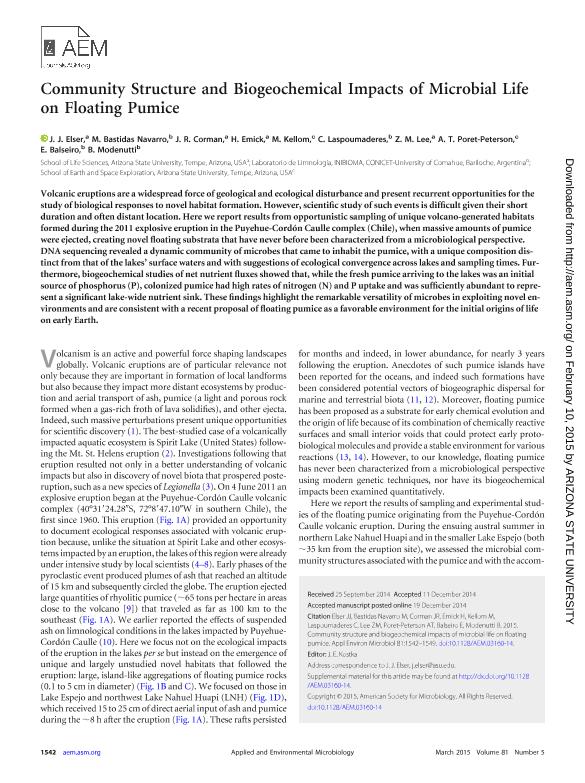Artículo
Community structure and biogeochemical impacts of microbial life on floating pumice
Elser, James J.; Bastidas Navarro, Marcela Alejandra ; Corman, Jessica R.; Emik, Hillary; Kellom, Matthew; Laspoumaderes, Cecilia
; Corman, Jessica R.; Emik, Hillary; Kellom, Matthew; Laspoumaderes, Cecilia ; Lee, Zarraz M.; Poret Peterson, Amisha; Balseiro, Esteban Gabriel
; Lee, Zarraz M.; Poret Peterson, Amisha; Balseiro, Esteban Gabriel ; Modenutti, Beatriz Estela
; Modenutti, Beatriz Estela
 ; Corman, Jessica R.; Emik, Hillary; Kellom, Matthew; Laspoumaderes, Cecilia
; Corman, Jessica R.; Emik, Hillary; Kellom, Matthew; Laspoumaderes, Cecilia ; Lee, Zarraz M.; Poret Peterson, Amisha; Balseiro, Esteban Gabriel
; Lee, Zarraz M.; Poret Peterson, Amisha; Balseiro, Esteban Gabriel ; Modenutti, Beatriz Estela
; Modenutti, Beatriz Estela
Fecha de publicación:
01/2015
Editorial:
American Society for Microbiology
Revista:
Applied And Environmental Microbiology
ISSN:
0099-2240
Idioma:
Inglés
Tipo de recurso:
Artículo publicado
Clasificación temática:
Resumen
Volcanic eruptions are a widespread force of geological and ecological disturbance and present recurrent opportunities for the study of biological responses to novel habitat formation. However, scientific study of such events is difficult given their short duration and often distant location. Here we report results from opportunistic sampling of unique volcano-generated habitats formed during the 2011 explosive eruption in the Puyehue-Cordón Caulle complex (Chile), when massive amounts of pumice were ejected, creating novel floating substrata that have never before been characterized from a microbiological perspective. DNA sequencing revealed a dynamic community of microbes that came to inhabit the pumice, with a unique composition distinct from that of the lakes' surface waters and with suggestions of ecological convergence across lakes and sampling times. Furthermore, biogeochemical studies of net nutrient fluxes showed that, while the fresh pumice arriving to the lakes was an initial source of phosphorus (P), colonized pumice had high rates of nitrogen (N) and P uptake and was sufficiently abundant to represent a significant lake-wide nutrient sink. These findings highlight the remarkable versatility of microbes in exploiting novel environments and are consistent with a recent proposal of floating pumice as a favorable environment for the initial origins of life on early Earth.
Palabras clave:
Pumice
,
Diversity
,
Nitrogen
,
Phosphorus
,
Lake
,
Patagonia
Archivos asociados
Licencia
Identificadores
Colecciones
Articulos(INIBIOMA)
Articulos de INST. DE INVEST.EN BIODIVERSIDAD Y MEDIOAMBIENTE
Articulos de INST. DE INVEST.EN BIODIVERSIDAD Y MEDIOAMBIENTE
Citación
Elser, James J.; Bastidas Navarro, Marcela Alejandra; Corman, Jessica R.; Emik, Hillary; Kellom, Matthew; et al.; Community structure and biogeochemical impacts of microbial life on floating pumice; American Society for Microbiology; Applied And Environmental Microbiology; 81; 5; 1-2015; 1542-1549
Compartir
Altmétricas



